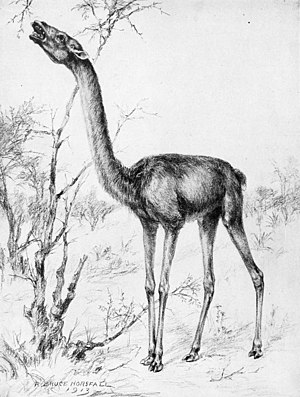Aepycamelus
| Aepycamelus | ||||||||||||
|---|---|---|---|---|---|---|---|---|---|---|---|---|

The living reconstruction from 1913 by Robert Bruce Horsfall gives an impression of the possible appearance of the animal. |
||||||||||||
| Temporal occurrence | ||||||||||||
| Lower Miocene to Upper Miocene | ||||||||||||
| 23 to 5 million years | ||||||||||||
| Locations | ||||||||||||
| Systematics | ||||||||||||
|
||||||||||||
| Scientific name | ||||||||||||
| Aepycamelus | ||||||||||||
| Macdonald , 1956 | ||||||||||||
Aepycamelus ( Syn .: Alticamelus ) is an extinct genus of camels from North America . Fossils of these animals are known from deposits of the late Miocene .
description
The name of the genus means "tall camel". The animals resemble a modern giraffe in their habitus : They were unusually long-legged and carried their heads on a very long neck up to three meters high. For comparison: a dromedary reaches a maximum height of about 2.3 meters at the hump. The representatives of Aepycamelus were inhabitants of open landscapes, where, unlike the ( recent ) camels living today, they fed on the foliage of the bushes and trees ( Foliovorie ).
As with the other Miocene camels, the foot was already trained like that of their relatives living today. The small hooves that were still present in the early camelids were already reduced and functionally replaced by the wide, elastic pads (callous soles), which enable camels to step firmly even on unsafe ground. Even the so characteristic of recent camels ambling was probably already exists. This gait is an effective way of moving in open terrain, where maneuverability plays only a minor role. It is documented in the fossilized tracks of Miocene camels.
Naming
In 1956, in his first description of Aepycamelus, Macdonald assigned the new genus to the species that had previously belonged to the younger synonym Alticamelus . Aepyicamelus ( ancient Greek αἰπύς aipýs "tall") is the Greek equivalent of Alticamelus ( Latin altus "tall"), which was introduced in 1901 by William Diller Matthew . So both names have the same meaning. The animal was originally described in 1869 by the American vertebrate paleontologist Joseph Leidy under the name Homocamelus .
species
- Aepycamelus alexandrae
- Aepycamelus bradyi
- Aepycamelus elrodi
- Aepycamelus giraffinus
- Aepycamelus major
- Aepycamelus priscus
- Aepycamelus procerus
- Aepycamelus robustus
- Aepycamelus stocki
literature
- Robert L. Carroll: Paleontology and Evolution of the Vertebrates. Georg Thieme Verlag, Stuttgart 1993, ISBN 3-13-774401-6 .
Individual evidence
- ↑ JR Macdonald: A new Clarendonian mammalian fauna from the Truckee Formation of western Nevada. In: Journal of Paleontology. 30, 1, 1956, ISSN 0022-3360 , pp. 186-202.